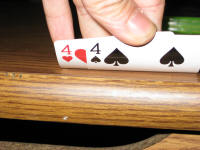Playing Small Pocket Pairs Postflop in No Limit Hold'em
(This article is a follow up to "Playing Small Pocket Pairs Preflop")
 Small pocket pairs are usually easy to play on the flop, because you either make an extremely strong hand (a set), or you miss the board and can easily release the hand. However, once in a while small pairs get into really tricky situations on the flop, including when you make a set on a dangerous flop, or when you feel like your opponent is trying to force you out of the pot.
Small pocket pairs are usually easy to play on the flop, because you either make an extremely strong hand (a set), or you miss the board and can easily release the hand. However, once in a while small pairs get into really tricky situations on the flop, including when you make a set on a dangerous flop, or when you feel like your opponent is trying to force you out of the pot.
This article is going to take a look at postflop play of small pocket pairs. We will consider factors such as your position at the table, your chip stack, the board texture, and your opponents' tendencies.
Small Pairs with No Help
If you limped in or called a raise preflop and then missed your set on the flop, you should throw your hand away to almost any bet. If the board comes out A-K-J off suit, there is very little chance your hand is good, especially if there is more than one other player in the hand.
If you were the preflop raiser and the board comes out A-K-J off suit, we recommend C-betting almost any board to try to take the pot right then and there, as you represented big cards with your preflop raise. If the other player calls or raises your bet on the flop you should slow down right away, because it is very that likely you are beat.
Flopping a Set
The best possible outcome with a small pocket pair is that you flop a set, meaning that your pocket pair matches up with a card on the board, giving you three of a kind. There are two ways to play a set on the flop:
- Fast
- Slow
Depending on the circumstances, either approach could be right.
Playing a Set Fast
If you act first on the flop, we recommend playing your set fast. This accomplishes a few things: first of all, it protects your hand from backdoor flush and straight draws. Second of all, you will likely induce a raise from any player who has top pair or an over pair. And third of all, you will receive value from players with mediocre hands like second pair who will call your flop bet to see what the turn brings.
Playing a Set Slow
If you act last on the flop, we recommend playing your set slow (unless the board is dangerous). If another player leads into you on the flop, just call and let him/her lead out again on the turn. If the other player checks to you, check behind him and hope that he improves on the turn.
The one exception to this rule is when you flop a set on a dangerous board. If the board comes out with three suited cards, or three cards to a straight, we recommend playing your set fast to protect your hand against draws. Learn more about playing a flopped set.
Making a Play with a Small Pair
Some situations will arise where stealing the pot with a small pair is a good idea. If you are in good position and call a preflop raise with a small pair, you should consider stealing the pot if the board comes out ragged. For example, if the board comes out 2d-6s-7c and you have pocket fours, you probably have the best hand.
If your opponent bets into you we recommend that you raise and try to steal the pot. If your opponent checks to you, bet out and try to win the pot right then. Checking behind on the flop is a bad idea because the other player could easily pair their over card on the turn.
Throwing a Set Away
Although it is unlikely, occasions do arise where you may be beat after flopping a set. Imagine that you have pocket sevens, and call a preflop raise by an extremely tight player. If the board comes out A-K-7, you should be very careful. Although your set of sevens is a very strong hand, the tight player may very well have pocket Aces or Kings.
If your opponent check-calls the flop, and then makes a huge bet on the turn or river, you should think long and hard to decide if your set is beat. There is no shame in throwing away a good hand if it saves you a lot of money.
